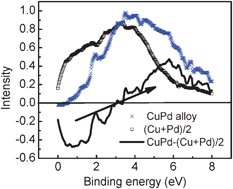Interface quantum trap depression and charge polarization in the CuPd and AgPd bimetallic alloy catalysts
Abstract
The ability of a

* Corresponding authors
a
School of Electrical and Electronic Engineering, Nanyang Technological University, Singapore 639798
E-mail:
Ecqsun@ntu.edu.sg
b Institute of Quantum Engineering and Micro-nano Energy, Key Laboratory of Low-Dimensional Materials and Application Technology, Faculty of Sceince, Xiangtan University, Changsha 411105, China
c Thin Film Laboratory, Department of Physics, Indian Institute of Technology, Delhi, New Delhi-110016, India
d Chemistry and Physics of Materials Unit, Jawaharlal Nehru Centre for Advanced Scientific Research, Jakkur, Bangalore-560064, India
e Institute of Materials Research and Engineering, Agency for Science, Technology and Research (A*STAR), Singapore 117602
f Engineering Research Center for Nanophotonics & Advanced Instrument, Ministry of Education, Department of Physics, East China Normal University, Shanghai 200062, China
The ability of a

 Please wait while we load your content...
Something went wrong. Try again?
Please wait while we load your content...
Something went wrong. Try again?
C. Q. Sun, Y. Wang, Y. G. Nie, B. R. Mehta, M. Khanuja, S. M. Shivaprasad, Y. Sun, J. S. Pan, L. K. Pan and Z. Sun, Phys. Chem. Chem. Phys., 2010, 12, 3131 DOI: 10.1039/B922677J
To request permission to reproduce material from this article, please go to the Copyright Clearance Center request page.
If you are an author contributing to an RSC publication, you do not need to request permission provided correct acknowledgement is given.
If you are the author of this article, you do not need to request permission to reproduce figures and diagrams provided correct acknowledgement is given. If you want to reproduce the whole article in a third-party publication (excluding your thesis/dissertation for which permission is not required) please go to the Copyright Clearance Center request page.
Read more about how to correctly acknowledge RSC content.
 Fetching data from CrossRef.
Fetching data from CrossRef.
This may take some time to load.
Loading related content
